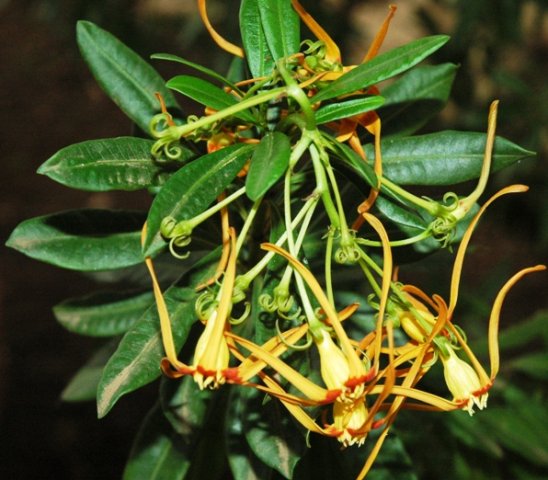Strophanthus speciosus

Author: Ivan Lätti
Photographer: Johan Wentzel
Strophanthus speciosus, commonly known as the poison rope or the forest poison rope, is a woody vine, a shrub or a small tree. It is often about 3 m tall but reaches around 20 m in forests where canopy height is a collective achievement (SA Tree List No. 649.6).
The main, spindly stem tends to branch. It is green with a covering of lenticels. The bark later becomes greenish brown, remaining smooth. Plant parts contain a watery sap.
In picture the flowers are old and flexing back their petal lobes, or have already lost them. Several pedicels are topped only by curly green calyces, one of the sepals forming a slightly bigger curl.
The fruit of this plant consists of paired or "twin-horned" slender follicles, as do the fruits of many Apocynaceae plants. S. speciosus follicles turn light brown and split open to release many seeds attached to tufts of silky hairs suited for wind dispersal. Such a seed horn can be up to 18 cm long and 1,5 cm wide.
The species distribution is in the eastern parts of South Africa, from the Eastern Cape and KwaZulu-Natal to Mpumalanga and Limpopo. The plants are also found in some neighbouring countries.
The habitat is mainly evergreen forest where this tree forms part of the canopy. It also grows in scrub forest, forest margins and narrow ravines at medium elevations. The habitat population is deemed of least concern early in the twenty first century.
The seeds and leaves contain poison that was used in the past for preparing arrows for the hunt. The roots are used medicinally in treating snakebite in cattle and people. Birds often build nests in this plant, whether it is a tree, a shrub or a climber (Coates Palgrave, 2002; Schmidt, et al, 2002; ; Leistner, (Ed.), 2000; Pooley, 1998; Onderstall, 1996; iNaturalist; https://pza.sanbi.org; http://redlist.sanbi.org).

